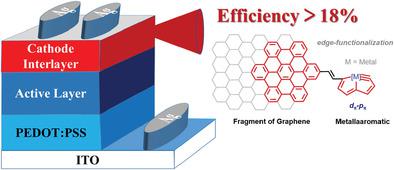当前位置:
X-MOL 学术
›
Adv. Mater.
›
论文详情
Our official English website, www.x-mol.net, welcomes your
feedback! (Note: you will need to create a separate account there.)
Nanographene–Osmapentalyne Complexes as a Cathode Interlayer in Organic Solar Cells Enhance Efficiency over 18%
Advanced Materials ( IF 27.4 ) Pub Date : 2021-06-12 , DOI: 10.1002/adma.202101279 Longzhu Liu 1 , Shiyan Chen 2 , Yangyang Qu 2 , Xiang Gao 2 , Liang Han 3 , Zhiwei Lin 2 , Liulin Yang 2 , Wei Wang 4 , Nan Zheng 5 , Yongye Liang 4 , Yuanzhi Tan 2 , Haiping Xia 1, 2, 3 , Feng He 1, 3
Advanced Materials ( IF 27.4 ) Pub Date : 2021-06-12 , DOI: 10.1002/adma.202101279 Longzhu Liu 1 , Shiyan Chen 2 , Yangyang Qu 2 , Xiang Gao 2 , Liang Han 3 , Zhiwei Lin 2 , Liulin Yang 2 , Wei Wang 4 , Nan Zheng 5 , Yongye Liang 4 , Yuanzhi Tan 2 , Haiping Xia 1, 2, 3 , Feng He 1, 3
Affiliation

|
Interface engineering is a critical method by which to efficiently enhance the photovoltaic performance of nonfullerene solar cells (NFSC). Herein, a series of metal–nanographene-containing large transition metal involving dπ–pπ conjugated systems by way of the addition reactions of osmapentalynes and p-diethynyl-hexabenzocoronenes is reported. Conjugated extensions are engineered to optimize the π-conjugation of these metal–nanographene molecules, which serve as alcohol-soluble cathode interlayer (CIL) materials. Upon extension of the π-conjugation, the power conversion efficiency (PCE) of PM6:BTP-eC9-based NFSCs increases from 16% to over 18%, giving the highest recorded PCE. It is deduced by X-ray crystallographic analysis, interfacial contact methods, morphology characterization, and carrier dynamics that modification of hexabenzocoronenes-styryl can effectively improve the short-circuit current density (Jsc) and fill factor of organic solar cells (OSCs), mainly due to the strong and ordered charge transfer, more matching energy level alignments, better interfacial contacts between the active layer and the electrodes, and regulated morphology. Consequently, the carrier transport is largely facilitated, and the carrier recombination is simultaneously impeded. These new CIL materials are broadly able to enhance the photovoltaic properties of OSCs in other systems, which provides a promising potential to serve as CILs for higher-quality OSCs.
中文翻译:

纳米石墨烯-Osmapentalyne 配合物作为有机太阳能电池中的阴极夹层将效率提高 18% 以上
界面工程是有效提高非富勒烯太阳能电池 (NFSC) 光伏性能的关键方法。在此,通过osmapentalynes和p的加成反应,一系列包含金属-纳米石墨烯的大过渡金属涉及d π - p π共轭体系报道了-二乙炔基-六苯并晕酮。共轭延伸设计用于优化这些金属-纳米石墨烯分子的 π 共轭,这些分子用作醇溶性阴极夹层 (CIL) 材料。随着 π 共轭的扩展,基于 PM6:BTP-eC9 的 NFSC 的功率转换效率 (PCE) 从 16% 增加到超过 18%,提供了最高记录的 PCE。通过X射线晶体学分析、界面接触法、形貌表征和载流子动力学推断,六苯并晕苯-苯乙烯基改性可以有效提高短路电流密度(J sc) 和有机太阳能电池 (OSC) 的填充因子,主要是由于强且有序的电荷转移、更匹配的能级排列、活性层和电极之间更好的界面接触以及受调节的形态。因此,极大地促进了载流子传输,同时阻碍了载流子重组。这些新的 CIL 材料广泛地能够增强其他系统中 OSC 的光伏特性,这为作为更高质量 OSC 的 CIL 提供了有希望的潜力。
更新日期:2021-07-28
中文翻译:

纳米石墨烯-Osmapentalyne 配合物作为有机太阳能电池中的阴极夹层将效率提高 18% 以上
界面工程是有效提高非富勒烯太阳能电池 (NFSC) 光伏性能的关键方法。在此,通过osmapentalynes和p的加成反应,一系列包含金属-纳米石墨烯的大过渡金属涉及d π - p π共轭体系报道了-二乙炔基-六苯并晕酮。共轭延伸设计用于优化这些金属-纳米石墨烯分子的 π 共轭,这些分子用作醇溶性阴极夹层 (CIL) 材料。随着 π 共轭的扩展,基于 PM6:BTP-eC9 的 NFSC 的功率转换效率 (PCE) 从 16% 增加到超过 18%,提供了最高记录的 PCE。通过X射线晶体学分析、界面接触法、形貌表征和载流子动力学推断,六苯并晕苯-苯乙烯基改性可以有效提高短路电流密度(J sc) 和有机太阳能电池 (OSC) 的填充因子,主要是由于强且有序的电荷转移、更匹配的能级排列、活性层和电极之间更好的界面接触以及受调节的形态。因此,极大地促进了载流子传输,同时阻碍了载流子重组。这些新的 CIL 材料广泛地能够增强其他系统中 OSC 的光伏特性,这为作为更高质量 OSC 的 CIL 提供了有希望的潜力。











































 京公网安备 11010802027423号
京公网安备 11010802027423号